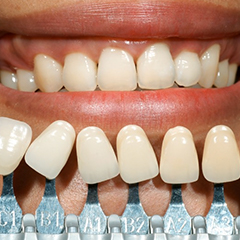
Dental Bonding can be considered to fix the following dental issues:
Once you schedule a consultation with your dentist, you can discuss your treatment goals together. Once you are comfortable with your treatment plan, your dentist will use a shade guide to select the correct composite resin color that matches your teeth. Your dentist will slightly etch the surface of the tooth to roughen it. The tooth will then to coated with a conditioning liquid which allows the bonding material to adhere.
When your tooth is prepped, your dentist will apply the composite resin and is molded and smoothed in its proper shape. An ultraviolet light is used to harden the material. Once the material has hardened, your dentist will further trim and shape it and polish the material until it matched the sheen of the rest of the tooth surface. To minimize the staining of the bonding material, you will need to avoid substances such as coffee, tea, red wine and smoking for 24-48 hours after bonding is performed.
Direct Composite Bonding: The process where dentist use tooth-colored composites that they have in their offices to fill cavities, repair chips or cracks, close gaps between your teeth and build up the worn-down edges of teeth.
Adhesive Bonding: The process of attaching a restoration to a tooth. This method is commonly used for esthetic crowns, porcelain veneers, bridges and inlays/onlays.
Dental bonding is a very affordable cosmetic dentistry procedure. Most dental insurances cover portions of dental procedure costs. The average cost for dental bonding can range from $150-$1,500.

Use emergency dental service to find emergency dentists near you that have the ability to care for all dental emergencies that may occur unexpectedly. Our patient support center is open to take emergency calls 24 hours a day 7 days each week and will connect you with multiple dentists that have walk-in appointment hours. To get started, call our 24/7 emergency dental service number: 1-888-350-1340, enter your zip code, and then wait to be connected with a dentist near you.
Emergency Weekend Dentist
Emergency Weekend Dentist
Emergency Weekend Dentist
Emergency Weekend Dentist
Emergency Weekend Dentist
Emergency Weekend Dentist
Emergency Weekend Dentist
Emergency Weekend Dentist
Emergency Weekend Dentist
Emergency Weekend Dentist